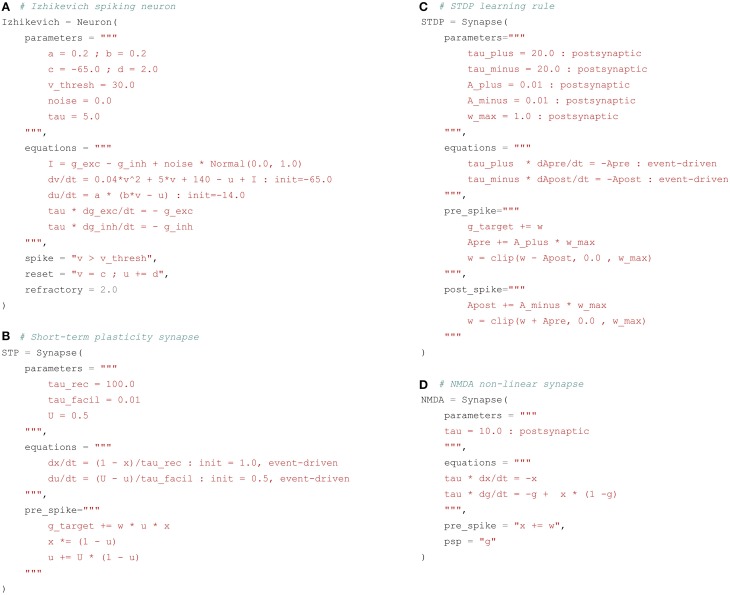Figure 3.
Examples of spiking neuron and synapse definitions. (A) Izhikevich neuron. The parameters and equations fields follow the same principles as for rate-coded neurons. The variable I gathers the inputs to the neuron, namely the sum of the excitatory g_exc and inhibitory g_inh input currents and a constant current i_offset. The membrane potential v and the recovery variable u are updated according to the desired dynamics, with initial values specified with the init keyword. The spike field defines the condition for emitting a spike, here when the membrane potential v exceeds the threshold v_thresh. The reset field specifies the modifications happening after a spike is emitted. Here the membrane potential is clamped to the value c and the recovery variable u is incremented by d. The refractory period is determined by the refractory field, here 2 ms. (B) Short-term plasticity (STP) synapse. For this synapse, the increment of the post-synaptic conductance g_target when a pre-synaptic spike arrives depends not only on the synaptic efficiency w, but also on the value of variables internal to the synapse x and u. These are updated through two mechanisms: the equations field specifies their exponentially-decreasing dynamics, while the pre_spike defines their increments when a pre-synaptic spike arrives at the synapse. However, the integration of the corresponding ODEs is event-driven through the use of the event-driven flag: when a pre- or post-synaptic spikes occurs, the new value of these variables is directly computed using the analytical solution of the ODE. This can speed up the simulation if the number of spiking events is low. (C) Spike-timing dependent plasticity (STDP) synapse. For this synapse, the post-synaptic conductance is increased by w after a pre-synaptic spike is received, but the synaptic efficiency is adapted depending on two internal variables Apre and Apost. The pre_spike field states what should happen when a pre-synaptic spike arrives at the synapse, while the post_spike field describes the changes occuring when the post-synaptic neuron fires. The variables Apre and Apost are integrated in an event-driven manner. The clip() function is used to maintain w in the range [0, w_max]. (D) NMDA non-linear synapse. This synapse does not transmit information to the post-synaptic neuron in an event-driven manner. Rather, the synaptic variable g is summed at each time step by the post-synaptic neuron, as for rate-coded networks. This is specified by the psp field. When a pre-synaptic spike occurs, the variable x is increased by w, which in turn will modify the evolution of g through the coupled equations described in the equations field. These equations cannot be solved with the event-driven method, as their values should be available at each time step.

